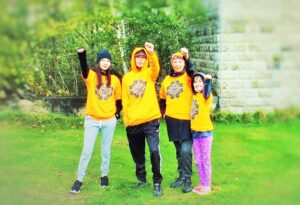A tribute bike ride to Ottawa from Saskatchewan
Trigger warning: readers may be triggered by the recount of Indian Residential Schools. To access a 24-hour National Crisis Line, call: 1-866-925-4419. Community Assistance Program (CAP) can be accessed for citizens of the Anishinabek Nation: 1-800-663-1142.

By Leslie Knibbs
LAKE HURON NORTH SHORE — As a tribute to children who attended Indian Residential Schools, a group of four individuals from Peter Ballantyne Cree Nation (PBCN) in northern Saskatchewan has been on a bike ride since Aug. 2, determined to reach Ottawa by Sept. 30, National Day for Truth and Reconciliation.
Riders include 41-year-old Veronique McCallum, her 21-year-old daughter Creedence, Samara Linklater aged 16, and the youngest daughter of Veronique, eight-year-old Kori Bear. Throughout their journey, the riders have taken turns riding the two bikes they are using. As of Sept. 25, the group had travelled 2,415 km. Reports from the group indicate that they are likely to arrive in Ottawa no later than Oct. 2; however, their goal is to reach their destination by Sept. 30. By Sept. 28, the group was east of North Bay heading for Ottawa.
Throughout their journey, the group has met and held ceremonies with several First Nations on their route. After reaching Ontario, they were welcomed by Batchewana, Ojibways of Garden River, Thessalon, and Mississauga #8 First Nations, as well as Nipissing First Nation. While on the North Shore of Lake Huron, the bicyclists enjoyed the hospitality of the warm and caring people of Mississauga #8 First Nation.
“We are very grateful to Melissa Morningstar and her husband Tom for taking us in for the past three nights and for the donation of four orange shirts from the Education Department in Mississaugi First Nation,” said Veronique.
Ojibways of Garden River First Nation showed generous support also to the cyclists.
“First, they invited us to a Pipe Ceremony at a Sacred Fire at Adrienne’s sister’s place, Theresa, in Garden River. Miigwech Theresa for having us and feeding us a delicious feast. We met very powerful Elders there and we were very grateful and honoured to go. After the ceremony, the people there donated some funds to us to help us in getting a room for the night. We ended up getting our room paid for by Georgina Naccarato at Super 8 that time,” noted Veronique.
When Veronique first heard of the 215 graves found at a former Indian Residential School in Kamloops, British Columbia, she was devastated. According to her, she first wanted to join Patricia Ballantyne when she started her walk but was unable to because of a scheduled knee surgery and other commitments, but knew she had to do something.
“I was waiting for surgery for years and I didn’t want to wait and reschedule it. I had knee surgery on July 21; it was a day surgery. I also had to move out of my house so I put all my stuff into a storage unit. I really wanted to do a Suicide Awareness walk in my community, too,” she added.
Making the journey would not have happened without the support of Veronique’s daughter Creedence and the others who joined her.
“I asked my girl to help me with the journey and the suicide awareness walks and she has been helping since,” she recollected. “We started on July 31 with our first Suicide Awareness walk in Sandy Bay, Saskatchewan, and then on Aug 1, we walked in Pelican Narrows, Saskatchewan. I was in a lot of pain from the surgery still but that wasn’t going to stop me. I also got diagnosed with rheumatoid arthritis in June of this year but I wasn’t going to let that stop me either. Something needed to be done and I felt this is one way of bringing healing and truth about the residential, industrial, and Day School systems.”
Samara did not mince words when speaking of why she took part in the memorial bike ride. Speaking of the children with a passion that perhaps most First Nation youths have.
“They couldn’t speak their own language or they would be hit, burnt, or starved and those who survived knows what else they did. They tried to scratch and scrape the colour of our people’s skin off so they could be more white. They picked and harvested food they couldn’t eat. If they were sick, if they were weak, it didn’t matter, they were forced to do labour work in these schools. The food they picked; they did not get, they were fed rotten, [mouldy] food, and expired milk. Our people cried and screamed to go home to their families, and they couldn’t. Every day that this bike I’m on, [it] gets hard; I have to remember that our people couldn’t no matter what they did.”
McCallum and her daughters, like many First Nation people, are left with a horrible legacy that was not wanted nor needed but forced upon them by the Canadian government and religious groups. The McCallum family history includes many relatives that were institutionalized by the residential school system.
“My mother went to residential school; my dad went to Day School and is Sixties Scoop Survivor; my brother went to residential school; I attended for a few days only until I ran away and didn’t go back; my grandmother, my dad’s mother Veronique who I am named after, went to the Sturgeon Landing residential school; my grandfather, my mother’s dad all went to residential school. Numerous aunties, uncles, cousins also went,” noted Veronique.


